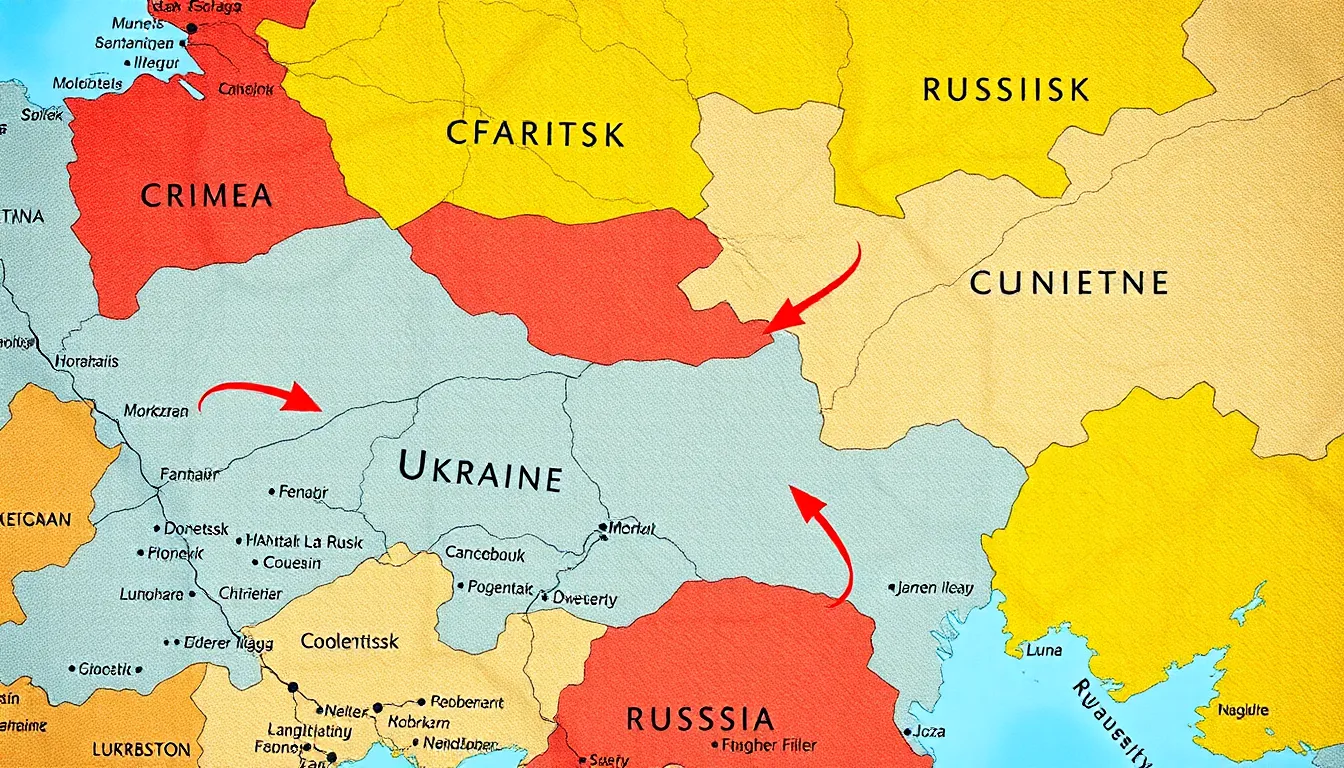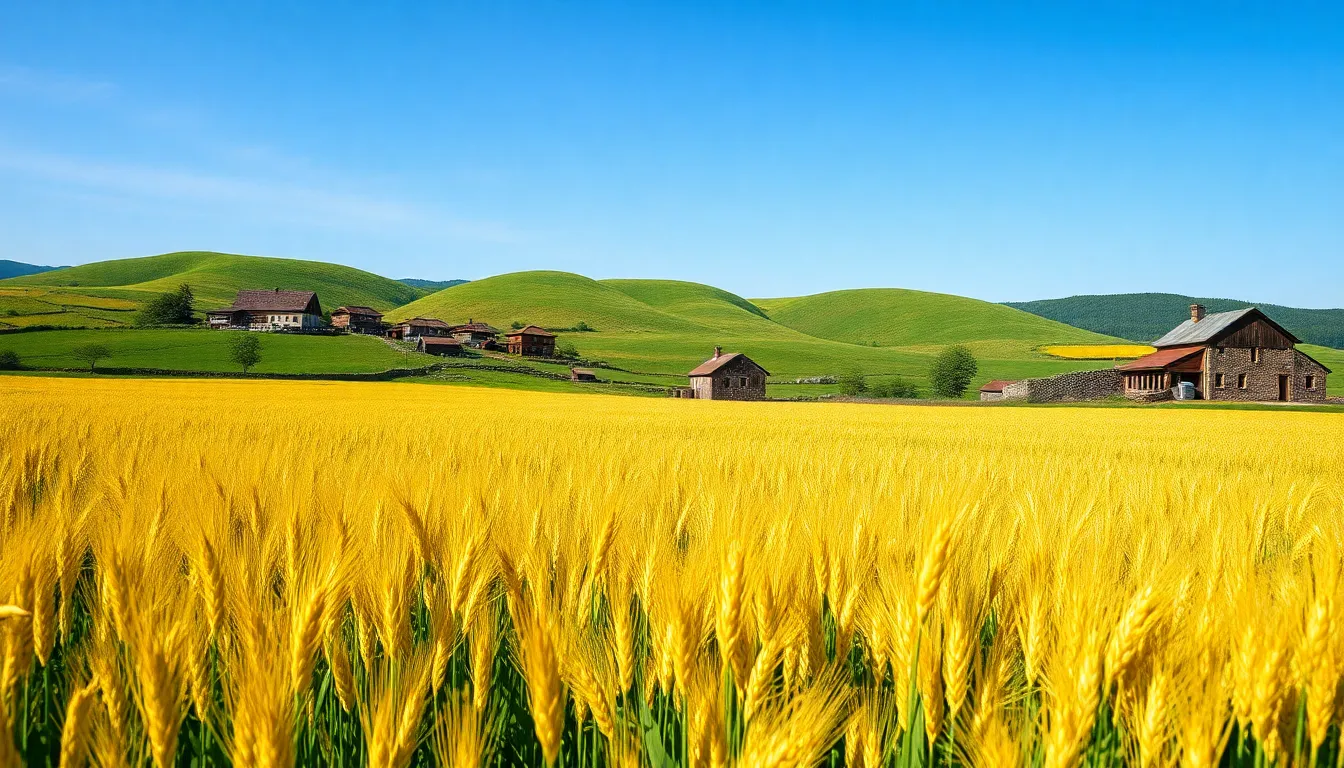In the ongoing conflict between Ukraine and Russia, a complex web of geopolitical interests and historical tensions fuels the struggle. At the heart of this clash lies the question: what does Ukraine have that Russia wants? Understanding this dynamic is crucial for grasping the motivations behind Russia’s aggressive actions.
Ukraine boasts rich natural resources, fertile agricultural land, and strategic geographic positioning. These factors not only contribute to its economic potential but also make it a valuable asset in the eyes of its larger neighbor. As the situation evolves, analyzing these elements sheds light on the broader implications for regional stability and international relations.
Table of Contents
ToggleOverview of Ukraine and Russia Relations
Ukraine and Russia share a complex relationship shaped by a long history of cultural ties and political conflict. Historical grievances and territorial disputes significantly affect their interactions. Key events, such as Ukraine’s 2014 Euromaidan protests and subsequent annexation of Crimea by Russia, intensified tensions further.
Economic factors remain central to their relationship. Ukraine, rich in natural resources, boasts substantial coal, natural gas reserves, and fertile agricultural land. These resources attract Russian interests, as control over them can enhance economic leverage. The agricultural sector, in particular, stands out with its production of grains, such as wheat and barley, leading to Ukraine being referred to as “Europe’s breadbasket.”
Strategically, Ukraine’s geographical location serves as a vital transit route for energy supplies from Russia to Europe. This positioning elevates its significance in regional energy security discussions. The ongoing competition for influence over Ukraine underscores the geopolitical stakes involved for Russia, Western nations, and the European Union. These dynamics continue to shape their evolving relations amid global political shifts.
Historical Context of Territorial Disputes

Understanding the historical context of territorial disputes between Ukraine and Russia reveals significant layers of complexity. Numerous events have shaped the current tensions, influencing geopolitical strategies and national identities.
Key Events Leading to Current Tensions
- Soviet Era Influence: The early 20th century saw Ukraine’s incorporation into the Soviet Union. This period fostered widespread cultural, political, and economic integration but also led to resentment over repression.
- Independence in 1991: Ukraine declared independence following the Soviet Union’s dissolution. This moment marked a critical shift, as Ukraine sought to assert its sovereignty, leading to ongoing disputes over its national identity.
- 2004 Orange Revolution: Public protests against electoral fraud underscored a societal split between pro-European and pro-Russian factions. This revolution crystallized Ukraine’s struggle for democratic governance and alignment with the West.
- 2014 Euromaidan Protests: Mass protests against the suspension of the EU Association Agreement intensified pro-Western sentiment. The ensuing political upheaval led to Russia’s annexation of Crimea, which escalated tensions dramatically.
- Ongoing Conflict in Eastern Ukraine: The emergence of pro-Russian separatist movements in Donetsk and Luhansk following Crimea’s annexation has sustained military confrontations. This conflict reflects the broader contest for influence in Ukraine.
The Role of International Relations
- NATO’s Expansion: NATO’s eastward expansion post-Cold War heightened Russian concerns about encirclement. Ukraine’s interest in NATO membership poses a direct challenge, intensifying geopolitical rivalries.
- EU Associations: Ukraine’s alignment with the European Union represents a significant shift in foreign policy. The EU’s support for Ukraine’s sovereignty resonates within the regional power dynamics, prompting Russian opposition.
- Western Sanctions on Russia: Following actions in Crimea and Eastern Ukraine, sanctions imposed by Western nations aim to curtail Russian aggression. These sanctions have significant economic ramifications for Russia, shaping its strategic responses.
- Global Energy Markets: Ukraine serves as a crucial transit route for Russian gas to Europe. Control over energy supply routes amplifies the geopolitical significance of Ukraine, influencing international relations.
- International Mediation Efforts: Various international organizations, including the OSCE and UN, seek to mediate the conflict. Their involvement reflects the global implications surrounding Ukraine, emphasizing the need for stability in the region.
Natural Resources in Ukraine
Ukraine boasts extensive natural resources that attract interest from Russia. Two key areas include agricultural wealth and mineral resources.
Agricultural Wealth
Ukraine’s agricultural landscape ranks among the most fertile globally, often referred to as the “breadbasket of Europe.” It primarily produces grains, with wheat and barley leading in output. In 2021, Ukraine produced approximately 33 million tons of wheat and around 10 million tons of barley. This agricultural strength secures its vital role in global food supply chains. Additionally, Ukraine generates substantial amounts of corn, sunflower oil, and soybeans, further enhancing its economic significance. The favorable climate and rich soil promote the cultivation of a variety of crops, making Ukraine a critical component in addressing food security concerns.
Mineral Resources
Ukraine’s mineral resources include significant reserves of coal, iron ore, and natural gas. In 2020, Ukraine ranked as one of the top ten coal producers, with output near 31 million tons. It holds approximately 3.5 billion tons of iron ore reserves, supporting its metallurgical industry. Natural gas reserves exceed 1 trillion cubic meters, essential for both domestic consumption and export. The country’s vast resource base positions it strategically in energy discussions, particularly related to European energy supply stability. The combination of these resources not only drives the economy but also raises interest from neighboring countries, underscoring their geopolitical importance.
Strategic Geographical Position
Ukraine’s strategic geographical position significantly influences its geopolitical importance to Russia. This not only affects military considerations but also shapes economic and energy dynamics in the region.
Access to the Black Sea
Access to the Black Sea enhances Ukraine’s strategic significance. The Black Sea serves as a critical maritime route for trade, energy exports, and military operations. Ukrainian ports, including Odesa and Mykolaiv, facilitate the transit of goods, impacting global supply chains. Control over these ports enables Russia to secure its maritime interests and project power in the region. Furthermore, the proximity to the Black Sea allows for naval deployments, which are vital for Russia’s military strategy aimed at countering NATO influence.
Proximity to NATO
Proximity to NATO countries amplifies Ukraine’s strategic relevance. Ukraine’s borders with NATO member states like Poland and Romania provide a buffer and logistical advantage for military operations and joint exercises. This proximity highlights Ukraine’s role as a frontline state in NATO’s efforts to deter Russian expansionism. As Ukraine approaches deeper integration with NATO, its geographical position becomes crucial in shaping the Alliance’s collective defense strategies. The potential for NATO membership further complicates Russia’s military calculus, as it fears encirclement and loss of influence in the region.
Cultural and Political Factors
Cultural and political dimensions play a crucial role in the ongoing conflict between Ukraine and Russia. These factors shape national identities and influence geopolitical strategies.
Shared History and Identity
Ukraine and Russia share a complex history, dating back to the establishment of the Kievan Rus’ in the 9th century. This historical bond encompasses shared cultural traditions, language, and religious ties. Despite these commonalities, significant differences in identity have emerged, particularly following Ukraine’s independence in 1991. The memory of imperial domination and the desire for self-determination fuel national sentiment in Ukraine. Events such as the Holodomor, a man-made famine in the 1930s, have deepened historical grievances, adding to Ukraine’s motivations for distancing itself from Russian influence. Narratives of oppression and resilience have further solidified a unique Ukrainian identity, diverging from Russian national identity and complicating relationships between the two countries.
Ukraine’s Shift Towards the West
Ukraine’s orientation toward Western institutions marks a significant shift in its geopolitical stance. The 2014 Euromaidan protests, which prioritized European integration, catalyzed this transformation. The desire to join the European Union and NATO reflects aspirations for political reforms, economic development, and security against Russian aggression. This pivot also brings Ukraine closer to Western political values and economic systems, contrasting sharply with Russia’s vision of a Eurasian sphere of influence. Ongoing negotiations with the EU and military cooperation with NATO underscore this strategic shift, intensifying Russia’s apprehensions about losing its historical leverage over Ukraine. As Ukraine strengthens ties with Western allies, it poses a challenge to Russia’s ambitions and sovereignty claims in the region.
Economic Implications
Ukraine’s economic landscape plays a critical role in the ongoing tensions with Russia. Several factors, including trade relations and investment potential, significantly influence the dynamics between these two nations.
Trade Relations
Ukraine’s trade relations are vital for both its economy and regional stability. In 2021, about 40% of Ukraine’s exports went to the European Union, highlighting its shift towards Western markets. Key exports include agricultural products, machinery, and metals, positioning Ukraine as a substantial supplier in global trade networks. Conversely, Russia remains a significant trading partner, especially in energy supplies.
Ukraine serves as a key transit hub for Russian natural gas flowing to Europe, with approximately 30% of the EU’s gas consumption passing through its pipelines. This dependence on Ukrainian infrastructure adds a layer of complexity to the energy security dynamics in the region. Trade disruptions, resulting from geopolitical conflict, can have cascading effects on supply chains and energy prices across Europe.
Potential for Investment
Investment potential in Ukraine is considerable, given its rich natural resources and strategic location. The country ranks among the top producers of grains, with wheat and barley output contributing significantly to international markets. In 2021, foreign direct investment (FDI) stood at around $4 billion, with sectors like agriculture, energy, and technology attracting interest.
Ukraine also boasts a large consumer market, which appeals to international businesses. The tech sector, in particular, has experienced rapid growth, presenting opportunities for digital innovation and startups. Global investors see Ukraine as an emerging market with the potential for high returns, especially if the political situation stabilizes.
Ukraine’s economic implications extend beyond its borders, affecting trade relations and investment strategies that ultimately influence regional stability and international dynamics.
Ukraine’s wealth in natural resources and strategic location makes it a focal point in the ongoing conflict with Russia. Its fertile land and mineral reserves are not just assets for Ukraine but also vital interests for Russia’s ambitions. The historical ties and cultural connections add layers to the complexity of this relationship.
As Ukraine continues to assert its independence and seek alignment with Western institutions, the stakes remain high. The interplay of economic potential and geopolitical significance will shape the future of both Ukraine and the region. Understanding these dynamics is crucial for grasping the broader implications of the conflict and the quest for stability in Eastern Europe.




